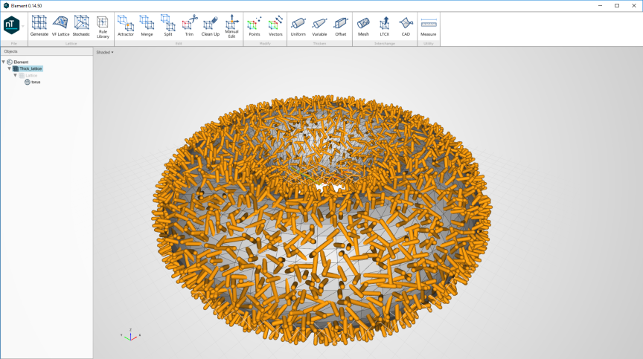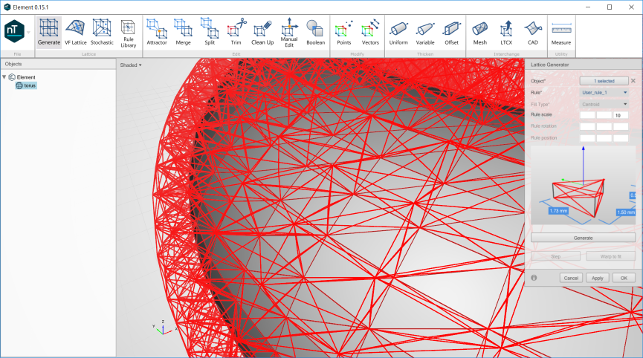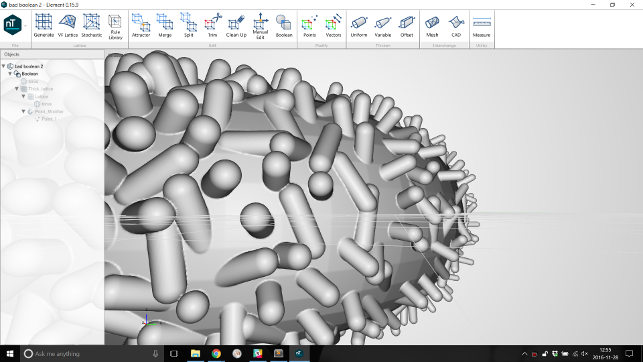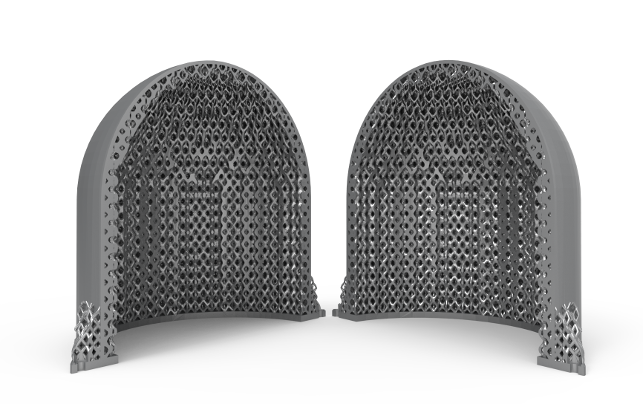
The Stochastic Structures module creates random structures to increase surface area
In 2015, the founding team of New York startup nTopology took on a big task. Drawing from their 2+ years designing 3D printed parts for clients, their goal now was to create dedicated software that will allow users to design and optimise their own highly complex lattice structures.
The first product it released – Element Free (which, as the name suggests, is a free to use Windows application) – features a set of lattice design tools allowing for the creation of complex structures with variable properties quickly and easily. It recently launched the professional version – Element Pro (which is a paid for tool) that adds powerful editing, analysis and data interchange features with Element Free’s lattice design tools.
D3D: Let’s start by going back to basics, how would you explain what a 3D lattice structure is?
Spencer Wright, VP Product nTopology: Speaking very generally, a lattice is any repeating cellular structure. In most applications, lattices are made from a series of cylindrical or conical beams which meet at spherical nodes. Lattices can vary a lot though. They may have millions of beams, and those beams can have any shape, orientation and thickness. You can also create lattices whose beams are not round (they might, for instance, have rectangular cross sections) and which follow a surface rather than filling a volume. The amount of variation among lattices is huge, and depends a lot on industry, application and the manufacturing process.

With Rule Builder users can design their own lattice rules
D3D: What are the advantages of such a structure and realistically how much weight can be taken out and strength improved?
SW: Because of the inherent variation in lattices, you can create what are called metamaterials – structures whose physical properties are very different from the bulk properties of the materials they’re made of. You can also vary these properties across a structure producing, for instance, a part which is very stiff in one region and very compliant in another. By doing this, you can optimise for exactly what your design requires whether that’s low mass, high surface area to volume ratio, or a specific Poisson’s ratio for tuned mechanical properties. In aerospace applications, our customers often get double-digit mass reductions by introducing lattices.
D3D: How does your lattice design software differ from others on the market?
SW: nTopology Element gives you a lot more control than the other lattice software out there. Our workflow is analogous to the CAD software that you’re already used to, and we interoperate with existing FEA and PLM systems. We can also generate a wider range of lattice types, including stochastic (random), conformal, and oriented surface lattices. And unlike our competitors, we make it *really* easy to download a free (and very powerful) version of our software to get started.
D3D: If users download your free tool Element Free, once installed on their PC how do they approach it from a blank sheet of paper?
SW: nTopology Element offers an optimisation step after traditional CAD and your print process. The most common workflow to try is a basic mass reduction. To start, find a bulky component and bring it into nTopology Element. Using our Generate tool, select the component and generate a lattice inside it. You can then warp or trim the lattice to fit the part, and then thicken it using either uniform or variable thickness. Then use our mesh tool to convert the thickened lattice to an STL and export it out to print!

The Productivity Pack module includes a built in Boolean tool to merge lattices with solid parts
D3D: Is it easily compatible with other FEA and CAD tools that the user has?
SW: Yes! We can import STL, OBJ or Parasolid files that are exported from an assembly-level CAD model, and can export those same formats to go to your FEA and/or CAM software. It’s also possible to design a part from scratch with nTopology Element – but most of our customers have a CAD/FEA/CAM workchain that they’re comfortable with, and we support them at every step.
D3D: What about production techniques? What processes does the software support?
SW: Our customers use a combination of metal powder bed fusion, selective laser sintering, stereolithography/digital light processing and other techniques. nTopology Element Free lets you export STL and OBJ files right out of the box, which can be used for any of those processes. In addition, our Pro customers can export lattices in our lightweight, open source fi le format (LTCX) that reduces fi le size by two orders of magnitude and can be used for file transfer, FEA and printing.
D3D: You’ve recently launched a Pro version of your Element software and that is available à la carte or full package. Why?
SW: Since lattices are used in such a wide range of industries, we off er a variety of purchasing options. Most industrial customers will want a full Pro package, but for niche applications and smaller companies we also sell individual Pro modules at a much lower cost. It’s really up to your needs – we’re happy to support you however we can!

The lattices in this pressure vessel were designed completely in Element Free
D3D: Lastly, there are typical industries that benefit from lattice structures (aerospace being the obvious one) but are there lesser known industries that can benefit too?
SW: Lattices are used extensively in aerospace where weight is a premium but we also have big user bases in medical implants (to improve recovery from surgery), footwear and apparel (to create high performance cushioning systems) and tool and die manufacturing (to reduce mass and allow for better thermal transfer). We also have a number of 3D printer manufacturers who use lattices to create specialised support structures and improve print time. The design freedom with lattices is *huge* and we’re really just scratching the surface so far!
Back to basics: Lattice design
Q I have a CAD model of a part that needs to maintain strength but lose some weight. Element Free sounds like it will do the job nicely. How do I get my hands on it?
A Element Free is a great place to start – it’s free to use and easy to get started with. Just go to our website (ntopology.com/elementfree) and fill out the form. We’ll send you a download link within about 15 minutes, and it takes just a minute to install.
Q I’ve never created a lattice structure before. Sounds exciting. What are the first steps? What should I consider before I start?
A Lattices are just repeating structures composed of beams and nodes, so the first thing to do is decide what you want your base structure to look like. Element Free makes that easy: we include a variety of different lattice cells, each of which will fill parts nicely and provide stiff ness in a few orientations. I recommend playing around a bit: try a few lattice cells on your part, and adjust the scale on them to get them to fill the space. Once you find a recipe that works, you thicken the lattice as a second step, and can control variable thickness with either manually-created data or an FEA result.
Q Any tips for perfecting my part? Any advice on combining the lattice with my more traditional CAD geometry?
A There are a lot of options here, but one that I usually recommend is making sure that you don’t have any “open beams.” An open beam is a beam that’s only connected on one side; in other words, it cantilevers out into space. These can be really hard to deal with in some software, but we make it easy – our “Clean up” tool identifies them and deletes them automatically. As far as solid regions go, you have a few options. First, you can use our Variable Thickener to merge multiple beams into a single solid mass. Alternately, you can use our (Pro) Boolean tool to combine a lattice with a solid, or export the lattice as an STL and use a Boolean tool in free software like MeshMixer.
Q Right, it’s all done. How do I know it’s good to send to the 3D printer?
A Once you have a thickened lattice that you like, just use our Mesh tool to create a printable version of the part. Then export it as an STL and bring it into your printer’s software to print!

We speak to VP of product, Spencer Wright
Default






